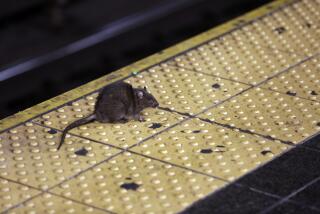Joint NASA-Soviet Project Studies Recovery From Injuries in Space : Science: Soviet researchers sent injured rats into orbit for two weeks. U.S. scientists are retracing the extent, if any, of the rodents’ healing process.
- Share via
MORGANTOWN, W. Va. — U.S. scientists are examining bits of leg muscle removed from high-flying rats as part of a joint NASA-Soviet experiment to determine how injured astronauts would heal in a weightless environment.
“Our hypotheses go everywhere from disaster to normal healing,” said William Stauber, a physiologist at West Virginia University Medical Center and one of two scientists conducting the study.
“A disaster would be if the muscle healed but you got cancer or just useless cells growing that wasted away,” Stauber said. “My guess is the answer is somewhere in between.”
Soviet researchers used forceps to crush the calf muscles of 10 specially bred rats from Czechoslovakia before placing them aboard a Vostok spacecraft for nearly two weeks last September.
“The bruise was similar to something a batter would get if he was hit by a pitched baseball at home plate,” Stauber said. “They tried to make it equivalent to a real-world situation.”
Within hours of the landing, researchers removed the rats’ calf muscles and froze them. Once in the United States, the muscle samples were shipped to Stauber and Barry Festoff, a neurologist at the Veteran’s Administration Hospital in Kansas City, Mo.
Festoff and Stauber are analyzing slides containing the red and white tissue to trace the healing and regrowth of the rats’ muscle cells and nerve fibers.
“We’re taking a look at the muscles themselves to see if they are any different from the rats who suffered the same injury but healed on Earth,” Stauber said.
He and Festoff brought Soviet officials up to date on their research recently at a meeting at NASA’s Ames Research Center in Mountain View, Calif.
“Long-term space flight may cause deconditioning of the cardiovascular, musculoskeletal, blood and immune systems,” A. S. Kaplansky, who oversees the program for the Soviets, said through an interpreter. “It is of crucial importance to clarify mechanisms underlying the changes and to develop effective countermeasures.”
The study is expected to be completed this fall. The results will be reviewed by Soviet scientists before the findings are published.
“Our very preliminary data would seem to indicate that repair after the crushing did not take place in the flight animals,” Festoff said.
Stauber said researchers also hope to gain a better understanding of how the human body reacts to heavy work in outer space--a critical consideration in light of a planned U.S. space station.
“I think there is a fair amount of knowledge of what happens to man if you’re out there floating around for a long time, but we really don’t know what happens when you start doing hard physical labor in space,” Stauber said.
Stauber said there may be “occupational hazards that we don’t know about.” It has been known for years that astronauts’ muscles atrophy during space flights, even relatively short ones.
And overuse injuries caused by working in a weightless environment are another concern, Stauber said.
“Behavior is going to be very different when we start working in space,” he said. “Legs will become perching devices used to push off and other light work while the upper body will be used more.”
The project is part of a longstanding agreement between the two superpowers to collaborate on space research.
“It goes back to 1973 and the Nixon Administration,” said Richard Grindeland, bio-specimen program manager for the Cosmos program at Ames.
“We have collaborated on seven space flights since 1975 using everything from guppies to monkeys,” Grindeland said. “It’s been an extremely good relationship, regardless of what the political climate has been.”
The experiments have included studies on the effect of space on the brain, immunity, red blood cells, and the endocrine, reproductive and digestive systems. The Soviets are committed to participating in an American space flight slated for 1991, and the United States is scheduled to take part in a Soviet flight in 1992.




